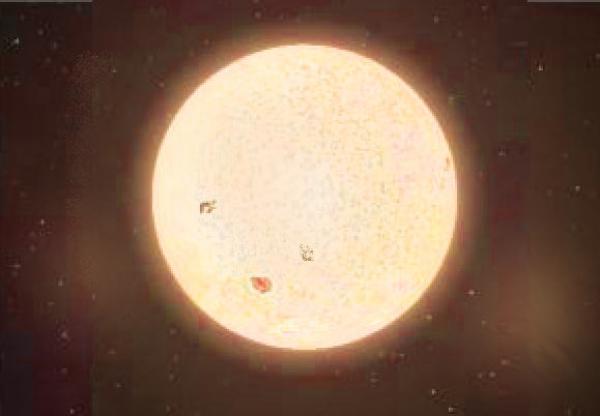BY LETTER
Red Dwarf
 Image from Steve Bowers | |
| Young red dwarfs often emit bright flares of ultraviolet light, which can radically alter the environment of surrounding planets | |
A small cool faint main sequence star, spectroscopic class M. Red Dwarfs put out most of their luminosity in the form of infra-red light; for this reason they appear dimmer than G-Class stars when viewed from the habitable zone. However many red dwarfs emit frequent, bright stellar flares, which are accompanied by bright UV emissions. Due to these flares some water-bearing worlds around these stars may develop oxygen-rich atmospheres via the process of abiotic photodissociation. Any biosphere which exists on such worlds must be capable of tolerating sudden bursts of UV light and high oxygen levels.
The habitable zone of most red dwarfs is small compared to other stars, and tidal effects mean that any planet that orbits within this zone will be tidally locked, or rotate in a simple resonance with its own orbital period. Earth-like tidally locked planets of this kind form the Vesperian subclass in the NOLWOCS classification system.
Because they are so cool red dwarfs burn slowly and hence live for a very long time. As they live longer and are formed more frequently than larger bodies they are the most common stars; there are about two thousand per million cubic light-years of galactic space. They are located at the bottom right of the Hertzsprung-Russell diagram.
 Image from Steve Bowers | |
| From a planet in the habitable zone, a red dwarf star will tend to look large in the sky; this is because of its low intrinsic brightness | |
As they get older, red dwarfs increase in luminosity but never become red giants or become white dwarfs. If left unmodified, many red dwarfs will eventually increase in brightness until they become as bright as a sun-like star; for smaller dwarfs, this era will not occur for a trillion years or so. Eventually the oldest dwarfs will cease to shine and become large, helium enriched black dwarfs, slowly radiating their heat and contracting.
Related Articles
- Apparent Brightness of the Local Sun
- Barnard's Star
- Bullseye
- Byrdis (also known as Kaa Yvanti)
- Chaihua (LTT 1445)
- Dante
- Eunchong (Gliese 832)
- Hiederia
- Huanghua
- Ixeway (HIP 94595)
- Kang 554-0-22/34 Gm-A - Text by M. Alan Kazlev
Negentropist outpost (an asteroid base around a small red star); one of the early victims of the "dirty wars" campaign developing as civilized standards fell apart as the Version War dragged on. In 4587 its cyborg inhabitants were infected by a Cyberian 'mutiny' program causing them to all challenge the chain of command at the same time, convinced those of higher rank were dooming the colony. This was a very early instance of what would become a common tactic of subversion of all forms of life. - Lok Mai
- Luyten's Star (Gliese 273)
- M-Type Star
- Megasov System, The
- Proxima Centauri (Alpha Centauri C)
- Star
Development Notes
Text by M. Alan Kazlev
Additional material by Steve Bowers
Initially published on 22 December 2001.
Additional material by Steve Bowers
Initially published on 22 December 2001.






